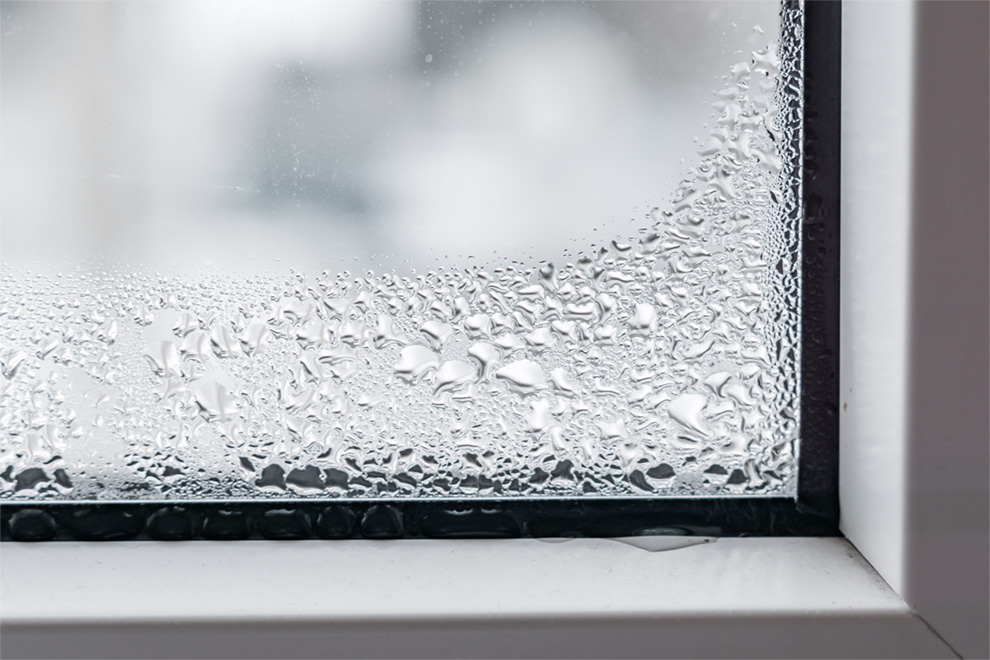Getting a Handle on Humidity
When the summer heat rises and humidity levels reach their peak—or in the winter when it’s much warmer inside than out—managing the moisture in the air is critical to protecting your home. Don’t sweat it, the Warranty Team is here to help with actionable advice and tips on how to master your HVAC system.
In the following, you’ll discover:
- why excess humidity (or not enough) is unhealthy for you and your home;
- your home’s ideal humidity level and how to reduce the moisture in the air; and
- what you need to know about your HVAC system and thermostat.
Are your windows covered in condensation, inside or outside? Is your hardwood flooring bowing or coming loose? Are there signs of moisture in the basement near the floor along the walls?
These are symptoms of possible dampness or the result of not having enough moisture in the air. Here’s how to get a handle on humidity in your home.

How to manage the humidity level in your home
Maintaining the relative humidity in your home is one of the most important ways of protecting your investment—including your belongings and your health. Controlling the moisture in the air extends your furniture’s life, prevents costly damage not covered by your Warranty, and keeps you and your family safe.
There are several ways to regulate humidity inside your home:
- Keep the air moving—create a cross breeze by positioning floor fans at opposite ends of the room and encourage airflow in and out of your living spaces. Remember, moving air helps manage high humidity levels.
- Push warm, damp air downward from the upper levels—prevent humidity from building up inside specific rooms of your home. Doing so protects your furniture, cabinetry, baseboards and flooring from excessive moisture.
- Turn on range hood fans and bathroom fans—draw the humid air out using the exhaust fans in your home. Not only does this eliminate humidity, but it helps you stay cooler in the summer without using the air conditioner as well.
- Know when to use your HRV and when not to—speak to a Warranty Team Member for insight on a schedule that’s best for your home’s model, elevation, features and finishes.
- Draw moist air out of the bathroom using exhaust fans—this reduces moisture and stops it from building up on your walls, vanity and flooring.
- Purchase a reliable dehumidifier and hygrometer(s)—you may not have ceiling and floor fans in your home, and while new homes are tight and energy efficient, different rooms will have different humidity levels. Gain control by monitoring and adjusting moisture in each room accordingly
Don’t forget, a little dampness in the air can be a good thing. While high humidity levels are unhealthy for you and your home, so is air that’s too dry. Lack of moisture will dry out wooden products like furniture, cabinetry and flooring, all while irritating your eyes and your throat.
In this case, reduce the use of fans, close windows and consider investing in a humidifier to increase the humidity in the air.
“What’s the ideal humidity level for a Minto Home?”
As a general rule of thumb, the relative humidity in your home should hover around 35%. Of course, this depends on the time of year and the temperature both inside and outside.
For example, during Ontario’s frigid winter when temperatures plummet below -24 degrees Celsius, it’s suggested to decrease the humidity level to about 25%. Accordingly, as the outside air heats up in the summer, moisture levels can reach beyond 50%.
When it comes to getting a handle on humidity, the goal is to find harmony between the temperature indoors and outdoors.
For more information on ideal humidity levels relative to the outside temperature, view the chart in our how to adjust your humidity according to the weather section.
What to know about your thermostat and ventilation system
Minto Homes and Townhomes include a programmable thermostat with your heat recovery ventilation (HVR) unit—this gives you superior control over the temperature and humidity level inside your home.
Set it and forget it with everyday regulation, and manage the indoor environment 24/7 with automatic temperature and fan adjustments.
In the winter, it’s recommended to program your home’s thermostat to maintain a comfortable 21 degrees Celsius during the day, and lowering it to 18 degrees overnight while you sleep—if you’re going to be away for a few days, remember to adjust your thermostat accordingly.
Did you know that lowering the temperature by just one degree can save you up to 3% on your heating bill? It’s true!
To learn more including additional insight on how to protect your home from damage not covered under warranty, contact the Warranty Team today.
